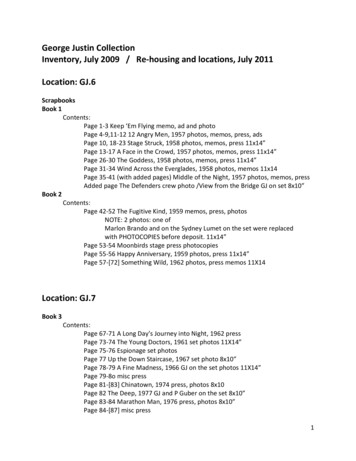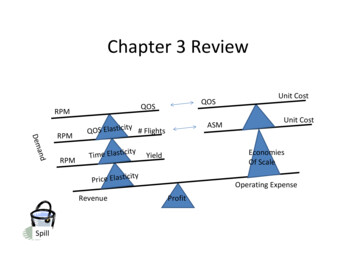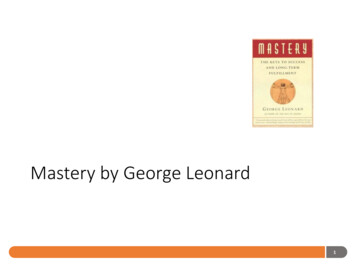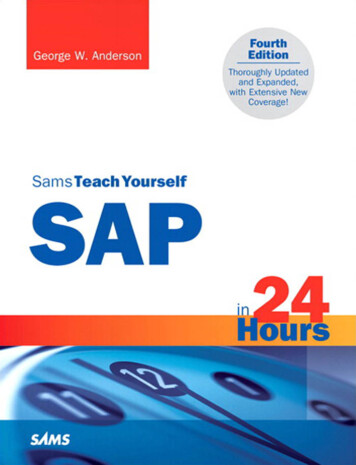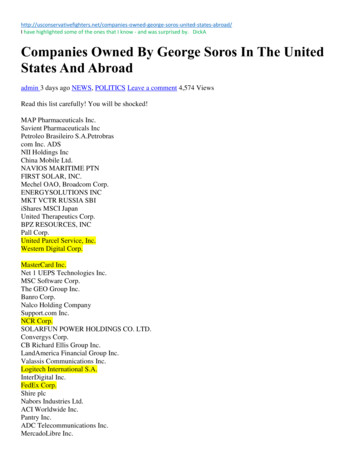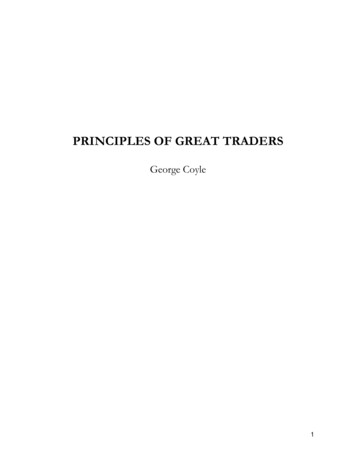
Transcription
PRINCIPLES OF GREAT TRADERSGeorge Coyle1
CONTENTS FOREWORD: 3INTRODUCTION: 4PERFECTION: 6SECRETS: 7CUTTING LOSSES: 8PRICE ACTION: 23RIDING WINNERS: 31PREDICTION: 40MANAGING EMOTIONS: 42OVERTRADING: 47BET SIZING: 54TRADE DURATION: 55TIPS & INSIDE INFORMATION: 59FUNDAMENTALS: 60DIVERSIFICATION: 62ENTERING TRADES: 64EXITING TRADES: 66CONCLUSION: 68ACKNOWLEDGEMENTS: 70ABOUT ME/THE RESEARCH: 71BIBLIOGRAPHY: 72TRADER COMMENTS: 75DISCLAIMER: 762
FOREWORDExplain something over and over for years and yearsand you might get it down to a few pips of pithy poetrythat stick to the soullike grass burrs on cotton socks.Navigate oceans of market mysteries for years and yearsand you might come to align your sextantto a few guiding stars that gain lustreas you weather the pitch and roll of trading.George Coyle, compulsive culler of quotations,saver of sayings and accumulator of aphorisms,herein generously presents his personal curationof epigrammatic market wisdom and wit.Come visit his cellar now, again and often.Walk the racks, inspect the vintages,imbibe his distillationsand savor the spirits of trading.Ed SeykotaAustin, TexasDecember 1, 20203
INTRODUCTIONThis research has been nearly 20 years in the making. As my career has progressed, Ihave continually read and reread books by and about famous traders. Over time,material stuck, and I started to see a lot of principles in common among the traders.This research is meant to highlight these principles in the words of the tradersthemselves. The main principles are: Cut losers Listen to price action/follow price trends Ride winnersThe secondary principles are: Manage emotions Don’t overtradeBeyond these practices, the great traders are much more varied in their tactics, butdocumented evidence of the principles goes back 100 years or more. This leads me towonder if the “secret” to successful trading isn’t just ensuring that the key principlesare met. Maybe the rest really doesn’t matter so much as long as you abide by them.The more I read, learn, and trade, the more I believe this to be true.To be clear, I am not a reporter. I am a trader/market researcher and I originally didthis research for myself to connect all the dots I was seeing to help my own process.If you’d like to know more including why I am giving this away, please see the “aboutme” section.That established, I should define “trader” versus “investor” or other terms. In thiscase, I will define a trader as someone whose market process includes the principlesabove. If I had to reduce it further, I would say a proactive process to cut losers meetsa healthy respect for price action are what differentiate a trader from a non-trader.So, what do I hope you take away from this research?4
First, while there is no perfect way to do things in the markets, I hope you will cometo see the principles as I have and will consider them in your process.Second, I hope my research helps you on your path to finding your own approach totrading. Or perhaps you will find you are not a trader which could be equally valuable.Finally, when I consider an investment (whatever the kind), I like to visualize myselfstanding across from a multi-tiered U.S. Senate testimony style panel of the greatesttraders of all time as I present my proposed investment to them. I like to envisiontheir responses to my various proposals. I know certain proposals would lead touniversal jeers amongst my hypothetical panel of pros. For example, leveraging 10:1on one idea with no stop-loss protocol would be universally frowned upon. In mymind’s eye, I can see the sidelong glances, hear the sighs and nays, and so on. In short,by knowing how the greats would respond I am more likely to follow their path tosuccess.In as much as my goal in trading is to make money, I want to be with the greats, notagainst them. And so, I hope you too will come away with the ability to visualize yourown seat across from the greats and know what they would likely say to your ideas,therein adapting your process to something that, at a minimum, does not defy thewisdom of generations of great traders. Few more points This research is repetitive at times. Repetition is the whole point, to show you that thesame messages show up over and over in the great traders of the past century, and intheir own words or the words of those closest to them. Keep in mind that repetitionand consistency over time provide the key to what really works. Turn that annoyanceinto a process that makes you money in markets.Finally, all of the materials I used throughout this research (see bibliography) providea lot more depth on the characters involved and their respective styles. Considerreading/viewing/listening to as much as you can to expand your knowledge.George CoyleChicago, IllinoisDecember 1, 20205
PERFECTIONTo begin, let's establish some expectations. Consider the following quotes: “No speculator can be right all the time.the truth is there is no investment whichdoesn’t involve some risk and is not something of a gamble.” - Bernard Baruch “No guide can be 100% right.” - Jesse Livermore “No system of forecasting the movements of the stock market can be infallible.” Humphrey Neill “.nothing is sure in any field of life.” - Gerald Loeb “You pays your money and you takes your chances.” - Richard Dennis “.what works most of the time is nearly the opposite of what works in the longrun.” - Bill Eckhardt “.[trend following] is going to stop working [for periods of time].” - JerryParker “There is no single trading or investment approach that works every time.” Larry Hite “In the markets, just about everything works sometimes, and hardly anythingworks all the time.” - Ed Seykota “Nothing works all the time.” - Bruce Kovner “There are periods of choppy markets when my style of investment is worse thanuseless.” - George Soros “Reality is.hoping that you can make a few bucks when conditions are good, andpraying that you’ll survive crashes, plagues, and earthquakes long enough so thatsomeday you’ll see the pleasant light of another bull market and have some moneyleft to play it.” - Martin ZweigIf these names don’t ring a bell, they will soon. In the meantime, take my word for itthat these are some heavy hitters and they're all telling you the same thing. Set yourexpectations accordingly.6
SECRETSAnother thing to consider is the “secret” to successful trading as told by our legends: “I can tell you a couple ‘secrets’ about purveyors of secrets: 1. There are no secrets.2. They don't want you to know that.” - Ed Seykota “Trade for the larger intermediate-trend profits and limit your losses. That is thesecret, if there is any.” - Humphrey Neill “The single hardest thing I have to do to make people understand how I trade isto convince them how wrong I can be about things, how much of a guess itis.They think that there’s some magic involved and that it’s not just trial anderror.there are no mysteries.” - Richard Dennis “That’s the secret of what we do, we’re going to continue to do it the same wayevery single time.we’re just gonna keep on selling that breakout and doing thosetrades.” - Jerry Parker “I just kept getting up and trying again. That’s the real secret of winning.” Larry Hite “.where I do think I excel is in recognizing my mistakes, you see. And that isthe secret to my success.” - George Soros “The secret for winning in the stock market does not include being right all thetime.The key is to lose the least amount of money possible when you are wrong.”- William O’NeilNone of these “secrets” seem that spectacular. With our expectations now, hopefully,firmly grounded in reality, let’s get down to it.7
CUTTING LOSSESI believe the single biggest factor responsible for the success of the great traders isthat they actively cut their losses. The reason I believe this is because an activemethod to cut losses is the main differentiator I have found between the legends andeveryone else. This may sound incredibly simple, and it is, but a lot of cognitiveaspects of human nature make what may seem simple on paper very difficult in reality.While we will discuss the psychological and emotional barriers to trading successshortly, let’s start by hearing what our legends have to say one at a time.Regarding the structure that follows, I have roughly grouped the traders based ontheir era or other similarities. I mostly stick to chronological order but will finishanalysis of a related group before moving to another group even if that causes a “timejump”. For example, if group A runs from 1970 to 1990 and group B runs from 1980to 2000, I will finish group A before moving to group B. Finally, I provide a briefintroduction to each trader as we progress, then sharing their quotes. Let’s start with agroup I refer to as the “Old Timers”.Bernard Baruch:According to Wikipedia, Bernard Baruch was, “.an American financier, stockinvestor, philanthropist, statesman, and political consultant.” His autobiography,Baruch My Own Story profiles Baruch’s life adventures and, like many older books,shows not much in human nature changes over time.Baruch was rather successful financially in his day and was considered one of thegreats of his time. If you live near New York, you might notice The City University ofNew York in Gramercy still bears his name. Let’s hear what he has to say aboutcutting losses: “One of the worst mistakes anyone can make is to hold on blindly and refuse toadmit that his judgement has been wrong.” “.if you have made a mistake.admit it immediately and take your loss.” “Don’t expect to be right all the time. If you have made a mistake, cut your lossesas quickly as possible.” “.in the stock market, the first loss is usually the smallest.”8
Jesse Livermore:Next up is Jesse Livermore. Livermore was a famed speculator from the early 1900s.He made and lost several fortunes. While his story doesn’t end so well (he killedhimself at the age of 63), he is one of the greats mentioned most frequently by hismodern-day equivalents.More than a few of the traders from Jack Schwager’s Market Wizards books havementioned Livermore as an inspiration and have said that Reminiscences of a StockOperator (a disguised biography of Livermore) is a must for anyone seeking to learnabout trading and the markets. Like Baruch, Livermore was a big advocate of cuttinglosers: “The speculator has to insure himself against considerable losses by taking thefirst small loss.” “Profits take care of themselves but losses never do.” “.protect yourself by selling your stock before the loss assumes larger proportions.”Humphrey Neill:As I was doing my research, I found that legendary trader Nicholas Darvas (more onhim soon) was a fan of Humphrey Neill’s Tape Reading and Market Tactics, so much sothat he read it repeatedly for inspiration. Thus, I grabbed a copy of the book. Itturned out to be a great find. Here is what he had to say regarding cutting losers: “No one may ever hope to become so expert that he never takes a loss.”“Why, then, continue stubbornly to stick it [losing position] out?”“Countless losses must be accepted: the problem is to limit the losses.”“If you cannot lose cheerfully, do not trade in the market!”9
Gerald Loeb:Gerald Loeb was another trader that I had never heard of before. I discovered him inone of the books of William O’Neil, the founder of Investor’s Business Daily. Darvas,also, was said to be a fan of Loeb. As with Neill, Loeb proved a terrific find. Here iswhat Loeb advocated regarding cutting losers: “Cutting losses is the one and only rule of markets that can be taught with theassurance that it is always the correct thing to do.” “Losses must always be ‘cut’. They must always be cut quickly, long before theybecome of any financial consequences.” “If the stock declines, it should be sold at a small and quick loss.” “After the elimination of a stock in this manner, the transaction must be, in asense, forgotten.”Nicolas Darvas:And now we get to Nicolas Darvas. I learned about Darvas, and his books, from atrend follower friend when I was twenty-three. Ed Seykota (coming soon) alsomentioned Darvas as an influence.Darvas was a ballroom dancer who traveled the world and started trading on the side.After many false starts and bad outcomes, which he documents in an entertaining andpainfully honest fashion in his various books, Darvas morphed his style. The style heultimately landed on, which made him his fortune, contained the principles describedin this research. Let’s hear what Darvas thinks about cutting losers: “I have discovered no loss-free Nirvana.”“Why not accept my mistakes realistically and sell immediately at a small loss?”“A non-gambler must get out when his stocks fall.”“.there is no such thing as cannot in the market.any stock can do anything.Iwas bound to be wrong half of the time.the first step I took in that direction wasto adopt what I called my quick-loss weapon.”10
“When the [prices] started to tumble downwards, that was the time to close theshow and sell out. My trailing stop-loss, which I moved up behind the rising priceof the stock, should take care of this automatically.” “I built a fortune.with the use of a single tool: the trailing stop loss.”Let’s pause for a second. The above is a pretty consistent message from the OldTimers. And this evidence comes over a significant time span. But it doesn’t stopthere! Let’s move forward to our next significant group that advocated the samethings starting in the late 1960s and early 1970s. We will refer to this group as theChicago Trend Traders.Richard Dennis:Richard Dennis is probably as close to a Horatio Alger story as one can get in reality.He started trading in 1970 with 400 and, in the next decade or so, turned that 400into somewhere near 200mm (yes, you read that right!). Let’s hear from Dennis: “After all is said and done, you have to minimize your loss
and savor the spirits of trading. Ed Seykota Austin, Texas December 1, 2020 . 4 INTRODUCTION This research has been nearly 20 years in the making. As my career has progressed, I have continually read and reread books by and about famous traders. Over time, material stuck, and I started to see a lot of principles in common among the traders. This research is meant to highlight these principles

